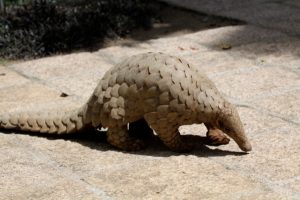Indian Pangolin
- Scientific Name : Manis crassicaudata

- IUCN : Endangered
- It is also called thick-tailed pangolin and scaly anteater is a pangolin native to the Indian subcontinent.
- Like other pangolins, it has large, overlapping scales on its body which act as armour.
- The colour of its scales varies depending on the colour of the earth in its surroundings.
- It can also curl itself into a ball as self-defence against predators such as the tiger.
- It is an insectivore feeding on ants and termites, digging them out of mounds and logs using its long claws, which are as long as its fore limbs.
- It is nocturnal and rests in deep burrows during the day.
- The Indian pangolin is a solitary, shy, slow-moving, nocturnal mammal.
- It is about 84–122 cm (33–48 in) long from head to tail, the tail usually being 33–47 cm (13–19 in) long, and weighs 10–16 kg (22–35 lb).
- The Indian pangolin has been recorded in various forest types, including Sri Lankan rainforest and plains to middle hill levels.
- It inhabits grasslands and secondary forests, and is well adapted to dry areas and desert regions, but prefers more barren, hilly regions.
- The Indian pangolin is nocturnal and mostly active intermittently between 17:00 and 05:00 hr.
- The peak period of activity was observed between 20:00–21:00 hr in captive individuals with some one individual variation.
- The Indian pangolin does not climb trees, but it does value the presence of trees, herbs, and shrubs in its habitat because it is easier to dig burrows around them.
- The Indian pangolin is an almost exclusive insectivore and principally subsists on ants and termites, which it catches with a specially adapted long, sticky tongue.
- The Indian pangolin is threatened by poaching for its meat and scales, which are used and consumed by local people, but are also increasingly traded internationally.
